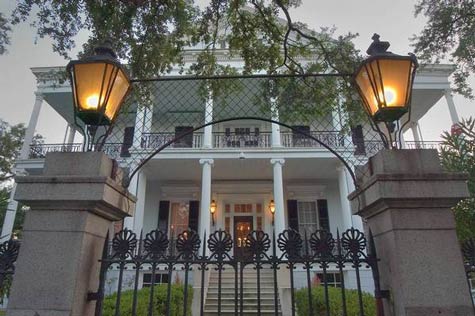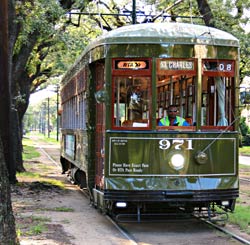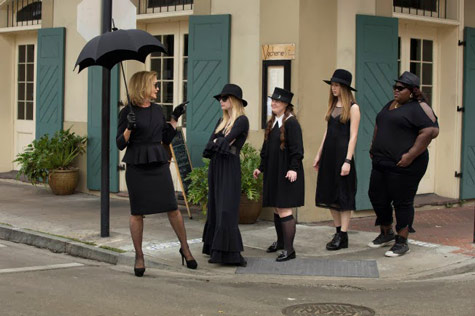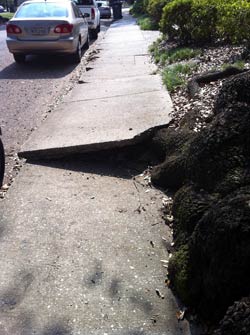
This post, about how a scenery-chewing TV series rekindled one New Orleans crime author's love for his own city, is offered for your delight and in commemoration of the 70th anniversary of Mystery Writers of America.
When it was announced that American Horror Story was setting its third season in New Orleans, and it was going to be about witches—well, I hoped for the best but prepared for the worst. The only thing more stereotypical than New Orleans witches/voodoo is vampires, and television shows haven’t been kind to New Orleans in the past, outside of Tremé. Another recent attempt, K-Ville (an abbreviation of Katrinaville), had been roundly mocked by everyone local—the Times-Picayune itself had a running gag about one of its more egregious mistakes (there’s no such thing as a gumbo party, y’all). There was an attempt to turn the much hated (locally) film The Big Easy into an equally hated series that lasted two seasons, and even Larry Hagman tried, post-Dallas, with a show called Orleans.
Given the uneven storytelling of the second season of American Horror Story, I didn’t hold out much hope for Coven. Yet as I watched, I found myself caught up, once again, in the spell of New Orleans.
More Cases of Places:
Sure, there were gaps in the story and holes in the plot big enough to fit a steamboat through, but they didn’t have gumbo parties or beignets or Hurricanes to drink. Yes, they played a little fast and loose with New Orleans history; with the stories of Marie Laveau and Madame LaLaurie—but it was kind of easy to forgive since they were so spot-on with our first, most notorious serial killer, the Axeman. While the stars of the show had meaty parts that enabled them to chew the scenery, for me the real star of Season 3 was New Orleans herself.
New Orleans caught me in her spell over twenty years ago. I stepped out of a cab onto the cracked and tilted sidewalks of the French Quarter and heard her siren song whisper into my ear: come live with me and I will make your dreams come true. I fell in love with a city, with the smell of grease hanging in the air, the swampy weather, the friendly people, and the beautiful architecture. After that visit, I knew that New Orleans had gotten into my blood and I had to live here. I made many pilgrimages to the city before I was finally able to move here, to the Lower Garden District. I’ve lived here ever since, never moving out of the same neighborhood—in fact, I’ve lived within a five-block radius for the last two decades.
 When New Orleans has captured you, you become fiercely defensive of her. New Orleanians hate nothing more than people who, in local parlance, “get it wrong.” There’s a rhythm that you can’t quite grasp until you live here, until you’ve waited twenty minutes for a streetcar only to have two pass you by because they’re full; until you’ve discussed with the cashier and the bagger at the grocery store about how it’s just not the same, now that the baby isn’t inside the king cake anymore; until you’ve been given directions to a downtown lakeside corner and you know what they mean. New Orleans always welcomes People Not From Here, but keeps a wary eye on them just the same.
When New Orleans has captured you, you become fiercely defensive of her. New Orleanians hate nothing more than people who, in local parlance, “get it wrong.” There’s a rhythm that you can’t quite grasp until you live here, until you’ve waited twenty minutes for a streetcar only to have two pass you by because they’re full; until you’ve discussed with the cashier and the bagger at the grocery store about how it’s just not the same, now that the baby isn’t inside the king cake anymore; until you’ve been given directions to a downtown lakeside corner and you know what they mean. New Orleans always welcomes People Not From Here, but keeps a wary eye on them just the same.
I’ve written, at this point, around twelve or thirteen novels set in the city, along with countless essays and short stories. But loving a place is no different than loving anything. After awhile, I’d started taking even a city as magical as New Orleans for granted.
I’d stopped noticing the beautiful old Victorian houses, the massive old, live oak trees with their gnarled branches, their curlicued roots breaking through the sidewalks. When you have to drive past Jackson Square on your way to and from work, or you have to go through the Garden District on your way to the grocery store, it’s easy to ignore the stunning, lush beauty. It’s easy to forget, as you go about your business and run your errands, that New Orleans is the city that came up with the phrase for standing on the curb waiting for a parade to show up: passin’ time.

 I’ve often joked that one of the reasons the people of New Orleans are so off-kilter and out of step with our fellow Americans is because we aren’t used, like the rest of the country, to being on a level surface. Everything in New Orleans tilts or is slanted, and there are no flat, even surfaces anywhere They even managed to capture this in AHS: Coven by never taking a straight-on shot: the camera’s view was either tilted to one side or shot upward, or the perspective was slightly askew. As a local author once famously said, “You want a level house? Move to the suburbs.”
I’ve often joked that one of the reasons the people of New Orleans are so off-kilter and out of step with our fellow Americans is because we aren’t used, like the rest of the country, to being on a level surface. Everything in New Orleans tilts or is slanted, and there are no flat, even surfaces anywhere They even managed to capture this in AHS: Coven by never taking a straight-on shot: the camera’s view was either tilted to one side or shot upward, or the perspective was slightly askew. As a local author once famously said, “You want a level house? Move to the suburbs.”
No, thanks. And I’ll never again need a television show to make me stop taking New Orleans for granted.
Leading image of Buckner mansion from house-crazy, where you can see more of the building's history in pictures. Sidewalk image from NOLAmusings.
Greg Herren is a New Orleans-based author and editor. Former editor of Lambda Book Report, he is also a co-founder of New Orleans’ annual Saints and Sinners Literary Festival. His novels include Murder in the Rue Chartres, called by the Times-Picayune “the most honest depiction of life in post-Katrina New Orleans published thus far.” He has published over fifty short stories in markets as varied as Ellery Queen’s Mystery Magazine, literary magazines, and the critically acclaimed anthology New Orleans Noir.
